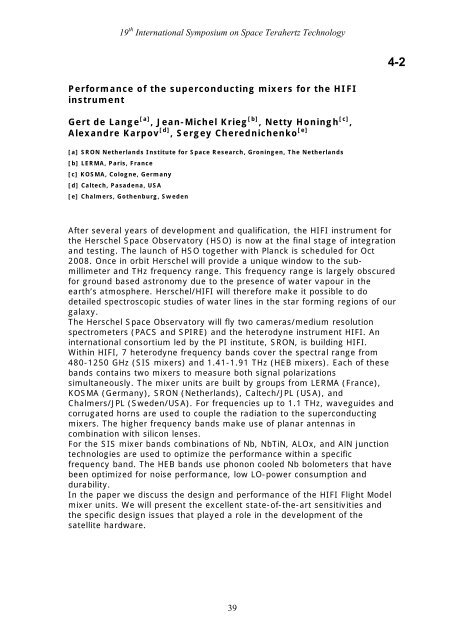Program and Abstract Book - SRON
Program and Abstract Book - SRON
Program and Abstract Book - SRON
You also want an ePaper? Increase the reach of your titles
YUMPU automatically turns print PDFs into web optimized ePapers that Google loves.
19 th International Symposium on Space Terahertz Technology<br />
4-2<br />
Performance of the superconducting mixers for the HIFI<br />
instrument<br />
Gert de Lange [a] , Jean-Michel Krieg [b] , Netty Honingh [c] ,<br />
Alex<strong>and</strong>re Karpov [d] , Sergey Cherednichenko [e]<br />
[a] <strong>SRON</strong> Netherl<strong>and</strong>s Institute for Space Research, Groningen, The Netherl<strong>and</strong>s<br />
[b] LERMA, Paris, France<br />
[c] KOSMA, Cologne, Germany<br />
[d] Caltech, Pasadena, USA<br />
[e] Chalmers, Gothenburg, Sweden<br />
After several years of development <strong>and</strong> qualification, the HIFI instrument for<br />
the Herschel Space Observatory (HSO) is now at the final stage of integration<br />
<strong>and</strong> testing. The launch of HSO together with Planck is scheduled for Oct<br />
2008. Once in orbit Herschel will provide a unique window to the submillimeter<br />
<strong>and</strong> THz frequency range. This frequency range is largely obscured<br />
for ground based astronomy due to the presence of water vapour in the<br />
earth’s atmosphere. Herschel/HIFI will therefore make it possible to do<br />
detailed spectroscopic studies of water lines in the star forming regions of our<br />
galaxy.<br />
The Herschel Space Observatory will fly two cameras/medium resolution<br />
spectrometers (PACS <strong>and</strong> SPIRE) <strong>and</strong> the heterodyne instrument HIFI. An<br />
international consortium led by the PI institute, <strong>SRON</strong>, is building HIFI.<br />
Within HIFI, 7 heterodyne frequency b<strong>and</strong>s cover the spectral range from<br />
480-1250 GHz (SIS mixers) <strong>and</strong> 1.41-1.91 THz (HEB mixers). Each of these<br />
b<strong>and</strong>s contains two mixers to measure both signal polarizations<br />
simultaneously. The mixer units are built by groups from LERMA (France),<br />
KOSMA (Germany), <strong>SRON</strong> (Netherl<strong>and</strong>s), Caltech/JPL (USA), <strong>and</strong><br />
Chalmers/JPL (Sweden/USA). For frequencies up to 1.1 THz, waveguides <strong>and</strong><br />
corrugated horns are used to couple the radiation to the superconducting<br />
mixers. The higher frequency b<strong>and</strong>s make use of planar antennas in<br />
combination with silicon lenses.<br />
For the SIS mixer b<strong>and</strong>s combinations of Nb, NbTiN, ALOx, <strong>and</strong> AlN junction<br />
technologies are used to optimize the performance within a specific<br />
frequency b<strong>and</strong>. The HEB b<strong>and</strong>s use phonon cooled Nb bolometers that have<br />
been optimized for noise performance, low LO-power consumption <strong>and</strong><br />
durability.<br />
In the paper we discuss the design <strong>and</strong> performance of the HIFI Flight Model<br />
mixer units. We will present the excellent state-of-the-art sensitivities <strong>and</strong><br />
the specific design issues that played a role in the development of the<br />
satellite hardware.<br />
39
















